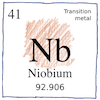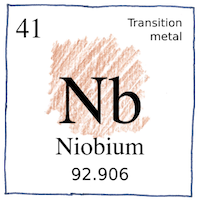London—Charles Hatchett
elements

|
Niobium
Charles Hatchett discovered its oxide in a sample of columbite at the British Museum and called it columbium. William Hyde Wollaston compared columbium oxide with tantalite and said they were the same although they had different densities. Heinrich Rose found three elements in tantalite, including tantalum (discovered just after columbium), and named them after the children of Tantalus: niobium and pelopium. R. Hermann found a new metal in samarskite and called it ilmenium. Franz von Kobell found a new metal in tantalite and called it dianium. Not to be outdone, R. Hermann found yet another new metal in tantalite and called it neptunium. Others—Christian Wilhelm Blomstrand, Henri Étienne Sainte-Claire Deville, Louis Joseph Troost, and Jean Charles Galissard de Marignac— showed that niobium was different from tantalum, that columbium and dianium were the same as niobium, and that ilmenium and pelopium were mixtures of the two. R. Hermann’s neptumium was probably a similar mixture, although by this point no one believed anything from R. Hermann.
Atomic number 41
Microalloyed stainless steels with less than a tenth of a percent of niobium are nevertheless tougher, stronger, more formable, and more weldable. * The Gemini program used superalloys of niobium with iron, nickel, cobalt, titanium, molybdenum, and aluminum. * Niobium alloys with tin or titanium are used for superconducting magnets. * Niobium is used for capacitors and mobile phone modulators.
Technical stuff
Columbite and tantalite are orthorhombic; tapiolite is tetragonal. Pyrochlore is often metamict.



The confusion over columbium persisted for sixty-five years and original name continues to be used in the United States. Columbium was named after columbite, named in turn after Christopher Columbus, because it was collected by John Winthrop, the first governer of Virginia.
Heinrich Rose named niobium after Niobe, the daughter of Tantalus in Greek mythology, because of the niobium’s relationship with tantalum, which Anders Gustaf Ekeberg named after Tantalus because the oxide of tantlum was insoluble in acid and metaphorically unable, as Tantalus in Hades, to quench its thirst.
See also in The book of science:
Readings in wikipedia:
Other readings: